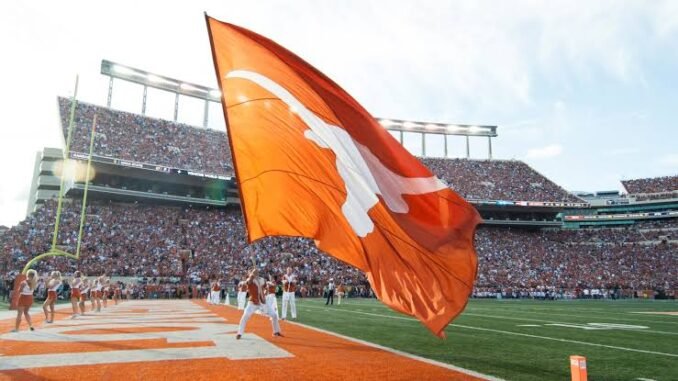
“Behind the Burnt Orange Curtain: The Power, People, and Money Behind Texas Longhorns Football”… read more…
In American college football, few programs shine as brightly—or spend as boldly—as the Texas Longhorns. With a rich history, national championship pedigree, and the largest revenue stream in college sports, Texas football isn’t just a team—it’s a machine. But who really owns that machine? Who controls it, funds it, and shapes its future?
The answer isn’t simple. Texas football is technically owned by the University of Texas at Austin. But behind the scenes, a coalition of administrators, donors, boosters, media deals, and even student-athletes through NIL have carved out influence over what many see as the most powerful program in the college football world.
A Public Program with Private Power
Texas Longhorns football is not a privately owned franchise. Unlike NFL teams, which are run by owners with full operational control, Texas football is owned and governed by the University of Texas at Austin—a public university. This means decisions are ultimately overseen by the University of Texas Board of Regents, a group that governs the entire UT System, including its athletic departments.
The daily operation of the athletic department, including football, is led by Athletic Director Chris Del Conte, a sharp strategist who has guided Texas through conference realignment, a historic NIL transition, and a record-breaking athletic budget.
But in reality, the university’s nameplate on the stadium wall is just one part of a much larger ecosystem of influence.
The Boosters: Financial Fuel and Silent Stakeholders
One of the most defining features of Texas football is the presence of a deep and powerful booster network. Wealthy alumni and corporate partners contribute millions annually to support scholarships, facilities, coaching salaries, and recruiting operations. Boosters operate through organizations like the Longhorn Foundation, UT’s official fundraising arm.
Though they hold no legal ownership, boosters are the closest thing Texas has to stakeholders in the program. Legendary names like Joe Jamail, Red McCombs, Tex Moncrief, and Mike Myers have shaped the Longhorn legacy—not from a suite or sideline, but from the donation ledger.
For instance, the McCombs Red Zone at Darrell K Royal-Texas Memorial Stadium wasn’t named for its color—it was named after the $50 million gift that built it.
The Money Game: College Football’s Most Expensive Brand
In 2024, the Texas athletic department became the first in NCAA history to cross $325 million in annual operating expenses, with over $204 million tied directly to football. Despite that monumental spending, the program still posted a net profit of over $8 million—a testament to its market dominance.
Texas generates revenue through ticket sales, merchandise, television contracts (now under the SEC Network umbrella), and sponsorships. But one of its most unique assets has been the Longhorn Network, a television partnership with ESPN launched in 2011, providing the school with a $300 million content pipeline.
Though the Longhorn Network is now set to merge into the broader SEC media family, its creation signaled something that still rings true: Texas runs its football brand like a Fortune 500 company.
Facilities as an Expression of Power
Ownership is also about infrastructure—and in that realm, Texas spares no expense. Darrell K Royal–Texas Memorial Stadium is one of the largest in the world, holding over 100,000 fans and undergoing constant upgrades. In 2021, the south end zone renovation added luxury suites, player lounges, and enhanced fan experiences.
Across the campus, the team enjoys state-of-the-art training centers, academic support buildings, and branding studios—all funded largely by donations. These aren’t just buildings—they are statements of intent: that Texas plans to dominate, in every way, forever.
NIL and the New Era of Player Influence
If Texas football once belonged to the university and was powered by donors, the 2020s introduced a third powerful force: the players themselves. With the rise of Name, Image, and Likeness (NIL) deals, athletes now command their own financial influence—often backed by university-aligned collectives.
Star quarterback Arch Manning, for example, reportedly earns $6.6 million annually in NIL—independent of university payroll. And Texas’ roster for 2025 is expected to earn $35 to $40 million, including over $20 million from direct revenue-sharing, making it the most expensive team in college football.
This player-empowered model shifts the dynamics. Texas athletes are no longer just students or symbols—they are stakeholders in the modern college sports economy.
Strategic Governance: Del Conte’s Power Play
At the center of all this influence stands Chris Del Conte, Texas’ athletic director. Since taking over in 2017, he has executed one of the most ambitious athletic transformations in NCAA history. His major moves:
- Guided Texas into the Southeastern Conference, opening doors to larger revenue.
- Restructured the NIL approach to include school-led revenue sharing—a national first.
- Oversaw record fundraising and development campaigns.
Del Conte may not be the “owner” of Texas football, but he’s certainly the architect of its current empire.
University Oversight and Public Responsibility
Despite all the private money and high salaries, Texas football is still accountable to public standards. The Board of Regents must approve major contracts and expansions. The program is subject to state audit. And any major scandals or NCAA violations reflect directly on the university itself.
This balance between public responsibility and private ambition defines the high-wire act Texas football walks every year.
The Verdict: Who Owns Texas Football?
Legally, it’s the people of Texas. Functionally, it’s a hybrid model:
- The university holds ownership.
- Boosters hold capital influence.
- Athletes now hold individual financial power.
- The athletic director charts the vision.
- And the fans—through passion and pressure—hold everyone accountable.
In a world of multimillion-dollar collectives, billion-dollar valuations, and billion-watt stadium lights, the question of ownership isn’t about one person or one office—it’s about a constantly evolving community of power. That’s what makes Texas football more than just a team. It’s a brand. A business. And a legacy.
And yes—it’s still all burnt orange.
Leave a Reply